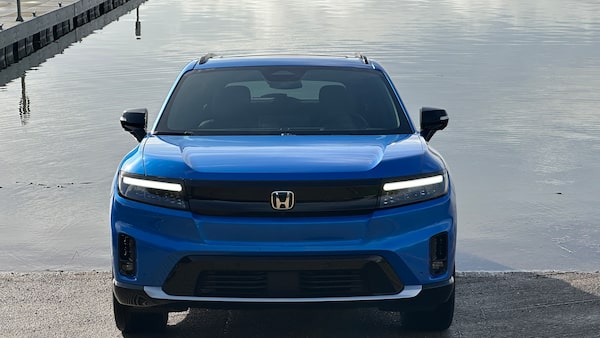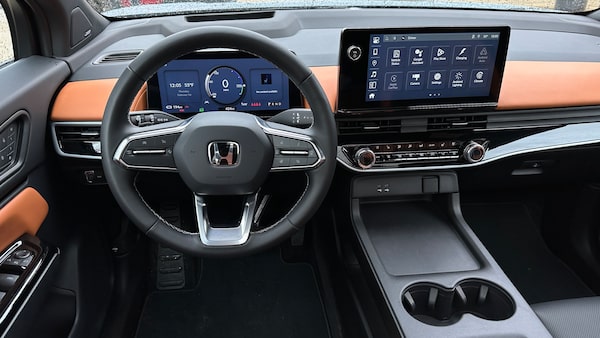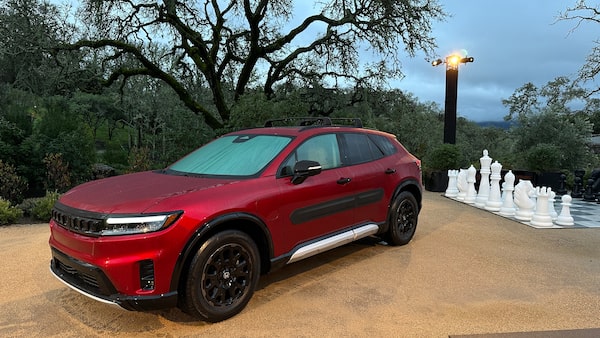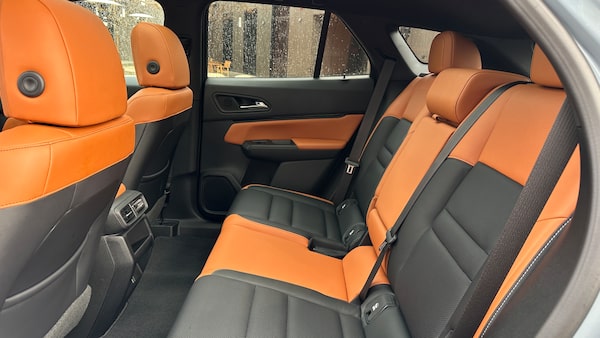
The 2024 Honda Prologue has a simple, friendly fact. Honda calls the design 'neo-rugged'.Mark Richardson/The Globe and Mail
If you live in Quebec or British Columbia, welcome to this review of Honda’s first all-electric vehicle for North America. It will come on sale at your dealerships this spring. If you live in Ontario, then welcome to you, too. You might be able to buy one if there are any left after dealers in those two provinces fulfill their orders, from the couple of thousand that will be brought into Canada each year. If you live anywhere else in Canada, just forget about it now. You’ll have to wait at least two more years.
It’s just business – nothing personal. Quebec and B.C. impose expensive penalties on automakers that don’t sell enough EVs and this is how Honda will avoid paying fines of thousands of dollars on every gas-powered vehicle it sells. It’s the same deal for Mazda with its MX-30 EV and Subaru with its Solterra EV – with no other electric vehicles in their showrooms, the priority goes to selling in Quebec and B.C. and minimizing those punitive payments.
Other governments in the United States and around the world have similar penalties to force automakers to provide electric powertrains, but Honda insists the new Prologue was not created to comply with those mandates. “We’re not doing this for just compliance, because compliance changes all the time, and that’s probably not a good strategy,” says Hayato Mori, Honda Canada’s assistant vice-president for business development. “Long term, we know that for Honda to reach its emissions goal (of carbon neutrality for all products and corporate activities by 2050), we know we have to go electrified, or some kind of technology other than internal combustion. Everybody claims that we’re slow, but I think we’re timely.”

In the centre, there is an 11.3-inch touchscreen and the instrument cluster is configurable.Mark Richardson/The Globe and Mail
Honda is working on its own in-house battery system and electric technology, called “e:architecture,” that will drive an all-new line of larger and smaller EVs starting in 2025. For now, however, the Japanese company is partnering with General Motors to use its latest-generation Ultium batteries, and is building the Prologue on the same platform as the Chevrolet Blazer EV, assembled at the same plant in Mexico.
Unfortunately, the launch of the Blazer EV late last year did not go well, and Chevrolet stopped sales, owing to myriad teething problems with the software. Mori says this will actually work to Honda’s advantage, to soothe the concerns of buyers who have placed deposits on the Prologue.
“One of the reasons why we didn’t go at the same time as our GM brother is so we can then do any counter measures as we discover some of the quality and initial production issues that GM is experiencing,” he says. “It’s all software, mostly. We have time on our hands to make sure we fix everything before we give them to our customers.”
So did Honda intentionally wait six months from the Blazer’s launch to use it as a guinea pig for the Prologue?
“I’m not going to say a guinea pig,” says Mori, “but again, GM went first, and we are learning from that experience so that we can countermeasure anything that we have.”

Honda built the Prologue on the same platform as the Chevrolet Blazer EV.Mark Richardson/The Globe and Mail
Tech specs
2024 Honda Prologue
- Base price/As tested: $61,990 / $71,990, including freight and pre-delivery inspection, plus fees and tax, less $5,000 federal rebate and potential provincial rebate
- Motor/Battery: Permanent magnet / 85 kilowatt-hour
- Horsepower/Torque: 288 horsepower / 333 lb-ft
- Drive: All-wheel drive
- Charging capacity: 150 kilowatts
- Range (claimed): 452 kilometres
- Alternatives: Chevrolet Blazer EV, Tesla Model Y, Kia EV6, Hyundai Ioniq 5, Ford Mustang Mach-e
Looks
The Prologue has a simple, friendly face that will offend no one. Honda calls it a “neo-rugged” design, whatever that means. Its smooth bodywork is uncluttered with creases, helping it to stand out from the more macho-looking Blazer. It’s considered to be a mid-sized crossover, the same length as the Honda Passport and larger than the popular CR-V compact SUV.
Interior

The back seats are spacious enough for two adults or three kids.Mark Richardson/The Globe and Mail
The cabin is simple and straightforward, with intuitive controls. There’s a configurable instrument cluster ahead of the steering wheel and an 11.3-inch central touchscreen that is apparently the highest definition yet seen in a Honda. I didn’t like the smooth black plastic of the centre console, however, which felt cheap, though the console itself works well enough for charging a smartphone and holding oversized coffee cups.
The seats are comfortable and there’s more legroom than the Passport in the second row. Headroom is generous too, so two adults will be happy seated back there, or three children. The windows are comparatively low, like the CR-V, providing excellent visibility for the driver while helping everyone to see the scenery outside.
Performance
The Prologue is quick, like most any EV these days, but not silly quick. A dab of the throttle will squirt it swiftly past traffic without slamming your head back against the seat. There is only one power option available in Canada: the all-wheel-drive edition with a motor for each axle that makes 288 horsepower and 333 lb-ft of torque. (Americans have the more affordable option of a single motor, front-wheel drive EV, tuned down to 212 horsepower and 236 lb-ft)
Flooding washed out the challenging roads for my drive in California, so I didn’t get to hurl the Prologue through many tight, twisting curves, but that’s not really what this vehicle is about. There’s a Sport drive mode in the Touring edition I drove, which is the high-end model of the three available trim lines, but I didn’t really notice much difference. If you want more power, as the Blazer EV offers with its RS edition, you’ll get it with the Acura ZDX that will be released this summer.
Technology
The Prologue benefits from using General Motors’ Ultium battery system, which is currently about as good as it gets for driving and swift charging efficiency. The temperature here was above freezing, so not a good measure for testing the realistic range in a true Canadian winter, but the clever Ultium system has so far proven itself to not degrade substantially in sub-zero conditions.
The claimed range of 452 kilometres is competitive with other brands. If you can find a Level 3 fast charger with at least 150 kilowatts of capacity, you can add 100 kilometres of charge in about 10 minutes.
Cargo

There is 714 litres of space behind the rear seats.Mark Richardson/The Globe and Mail
On paper, the Prologue seems spacious, with 714 litres of space behind the rear seats, and 1,634 litres when those seats are folded flat. The roof is low, however, and the floor is still high because of the batteries underneath, so it’s a relatively shallow area back there. A friend wrote to ask if she could fit her two large dogs in the back and while this is possible, it will be a high jump from the ground.
The verdict
The Prologue is a pleasant and advanced electric vehicle. It’s the same price as most other EVs, which means it’s expensive without rebates. However, if you’re on the fence about going electric and holding out for Honda, the new e:architecture that it’s developing with its own research will come out in a couple of years and might be a better long-term bet.
The writer was a guest of the automaker. Content was not subject to approval.
Shopping for a new car? Check out the new Globe Drive Build and Price Tool to see the latest discounts, rebates and rates on new cars, trucks and SUVs. Click here to get your price.